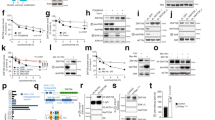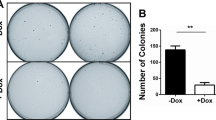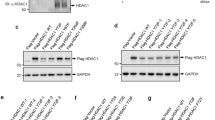Abstract
The Ras-mitogen activated protein kinase (Ras-MAPK) pathway plays an integral role in the formation of human malignancies. Stimulation of this pathway results in phosphorylation of histone H3 at serines 10 and 28 and expression of immediate-early genes. Phosphorylated (serine 10) H3, which is also acetylated on lysine 14, is associated with immediate-early genes. In this report, we investigated the relationship between these two H3 phosphorylation events in parental and ras-transformed fibroblasts. Immunoblot analyses of two-dimensional gel patterns demonstrated that all three H3 variants were phosphorylated after stimulation of the Ras-MAPK pathway and during mitosis. Following stimulation of the Ras-MAPK pathway, H3 phosphorylated on serines 10 and 28 was excluded from regions of highly condensed chromatin and was present in increased levels in ras-transformed cells. Although H3 phosphorylated at serine 10 or 28 was dynamically acetylated, H3 phosphorylated at serine 28 had a higher steady state of acetylation than that of H3 phosphorylated at serine 10. When visualized with indirect immunofluorescence, most foci of phosphorylated serine 28 H3 did not co-localize with foci of H3 phosphorylated on serine 10 or phosphoacetylated on serine 10 and lysine 14, suggesting that these two phosphorylation events act separately to promote gene expression.
This is a preview of subscription content, access via your institution
Access options
Subscribe to this journal
Receive 50 print issues and online access
$259.00 per year
only $5.18 per issue
Buy this article
- Purchase on Springer Link
- Instant access to full article PDF
Prices may be subject to local taxes which are calculated during checkout







Similar content being viewed by others
References
Ahmad K and Henikoff S . (2002). Mol. Cell, 9, 1191–1200.
Campbell PM and Der CJ . (2004). Semin. Cancer Biol., 14, 105–114.
Chadee DN, Hendzel MJ, Tylipski CP, Allis CD, Bazett-Jones DP, Wright JA and Davie JR . (1999). J. Biol. Chem., 274, 24914–24920.
Chadee DN, Taylor WR, Hurta RAR, Allis CD, Wright JA and Davie JR . (1995). J. Biol. Chem., 270, 20098–20105.
Cheung P, Allis CD and Sassone-Corsi P . (2000a). Cell, 103, 263–271.
Cheung P, Tanner KG, Cheung WL, Sassone-Corsi P, Denu JM and Allis CD . (2000b). Mol. Cell, 5, 905–915.
Clayton AL and Mahadevan LC . (2003). FEBS Lett., 546, 51–58.
Clayton AL, Rose S, Barratt MJ and Mahadevan LC . (2000). EMBO J., 19, 3714–3726.
Davie JR . (2003). Sci. STKE, 195, PE33.
Dimitrov SI and Wolffe AP . (1997). Methods, 12, 57–61.
Drobic B, Espino PS and Davie JR . (2004). Cancer Res., 64, 9076–9079.
Edmunds JW and Mahadevan LC . (2004). J. Cell Sci., 117, 3715–3723.
Egan SE, McClarty GA, Jarolim L, Wright JA, Spiro I, Hager G and Greenberg AH . (1987). Mol. Cell. Biol., 7, 830–837.
Espino P, Drobic B, Dunn KL and Davie JR . (2005). J. Cell Biochem., in press.
Fischer AH, Chadee DN, Wright JA, Gansler TS and Davie JR . (1998). J. Cell. Biochem., 70, 130–140.
Hendzel MJ and Davie JR . (1990). Biochem. J., 271, 67–73.
Hendzel MJ, Wei Y, Mancini MA, Van Hooser A, Ranalli T, Brinkely BR, Bazett-Jones DP and Allis CD . (1997). Chromosoma, 106, 348–360.
Henikoff S, Furuyama T and Ahmad K . (2004). Trends Genet., 20, 320–326.
Kireeva ML, Walter W, Tchernajenko V, Bondarenko V, Kashlev M and Studitsky VM . (2002). Mol. Cell, 9, 541–552.
Kruhlak MJ, Hendzel MJ, Fischle W, Bertos NR, Hameed S, Yang XJ, Verdin E and Bazett-Jones DP . (2001). J. Biol. Chem., 276, 38307–38319.
Laitinen J, Sistonen L, Alitalo K and Holtta E . (1990). J. Cell. Biol., 111, 9–17.
Lim JH, Catez F, Birger Y, West KL, Prymakowska-Bosak M, Postnikov YV and Bustin M . (2004). Mol. Cell, 15, 573–584.
Litt MD, Simpson M, Gaszner M, Allis CD and Felsenfeld G . (2001). Science, 293, 2453–2455.
Mahadevan LC, Willis AC and Barratt MJ . (1991). Cell, 65, 775–783.
McKittrick E, Gafken PR, Ahmad K and Henikoff S . (2004). Proc. Natl. Acad. Sci. USA, 101, 1525–1530.
Nowak SJ and Corces VG . (2004). Trends Genet., 20, 214–220.
Ridsdale JA and Davie JR . (1987). Nucleic Acids Res., 15, 1081–1096.
Samuel SK, Minish TM and Davie JR . (1997). Cancer Res., 57, 147–151.
Schubeler D, MacAlpine DM, Scalzo D, Wirbelauer C, Kooperberg C, van Leeuwen F, Gottschling DE, O’Neill LP, Turner BM, Delrow J, Bell SP and Groudine M . (2004). Genes Dev., 18, 1263–1271.
Soloaga A, Thomson S, Wiggin GR, Rampersaud N, Dyson MH, Hazzalin CA, Mahadevan LC and Arthur JS . (2003). EMBO J., 22, 2788–2797.
Strelkov IS and Davie JR . (2002). Cancer Res., 62, 75–78.
Tagami H, Ray-Gallet D, Almouzni G and Nakatani Y . (2004). Cell, 116, 51–61.
Taylor WR, Chadee DN, Allis CD, Wright JA and Davie JR . (1995). FEBS Lett., 377, 51–53.
Thomson S, Clayton AL, Hazzalin CA, Rose S, Barratt MJ and Mahadevan LC . (1999). EMBO J., 18, 4779–4793.
Thomson S, Clayton AL and Mahadevan LC . (2001). Mol. Cell, 8, 1231–1241.
Van Holde KE, Lohr DE and Robert C . (1992). J. Biol. Chem., 267, 2837–2840.
Waterborg JH . (1993). J. Biol. Chem., 268, 4912–4917.
Workman JL and Abmayr SM . (2004). Proc. Natl. Acad. Sci. USA, 101, 1429–1430.
Zhong S, Jansen C, She QB, Goto H, Inagaki M, Bode AM, Ma WY and Dong Z . (2001a). J. Biol. Chem., 276, 33213–33219.
Zhong S, Zhang Y, Jansen C, Goto H, Inagaki M and Dong Z . (2001b). J. Biol. Chem., 276, 12932–12937.
Zlatanova J, Leuba SH and Van Holde K . (1998). Biophys. J., 74, 2554–2566.
Acknowledgements
This research was supported by a grant from the National Cancer Institute of Canada with funds from the Canadian Cancer Society, a Canada Research Chair to JRD, and a KM Hunter/CIHR Doctoral Research Award to KLD.
Author information
Authors and Affiliations
Corresponding author
Rights and permissions
About this article
Cite this article
Dunn, K., Davie, J. Stimulation of the Ras-MAPK pathway leads to independent phosphorylation of histone H3 on serine 10 and 28. Oncogene 24, 3492–3502 (2005). https://doi.org/10.1038/sj.onc.1208521
Received:
Revised:
Accepted:
Published:
Issue Date:
DOI: https://doi.org/10.1038/sj.onc.1208521
Keywords
This article is cited by
-
IER2-induced senescence drives melanoma invasion through osteopontin
Oncogene (2021)
-
Programmable human histone phosphorylation and gene activation using a CRISPR/Cas9-based chromatin kinase
Nature Communications (2021)
-
Megakaryocytes contain extranuclear histones and may be a source of platelet-associated histones during sepsis
Scientific Reports (2020)
-
BRWD1 orchestrates epigenetic landscape of late B lymphopoiesis
Nature Communications (2018)
-
Histone reader BRWD1 targets and restricts recombination to the Igk locus
Nature Immunology (2015)



